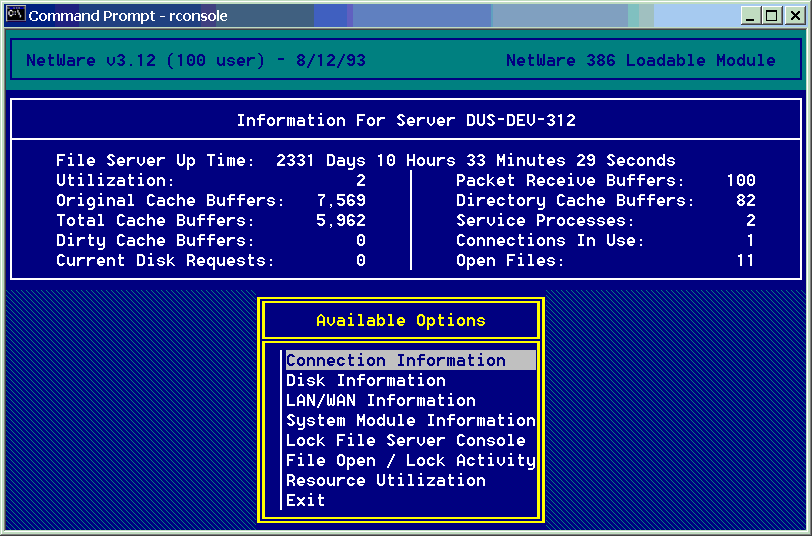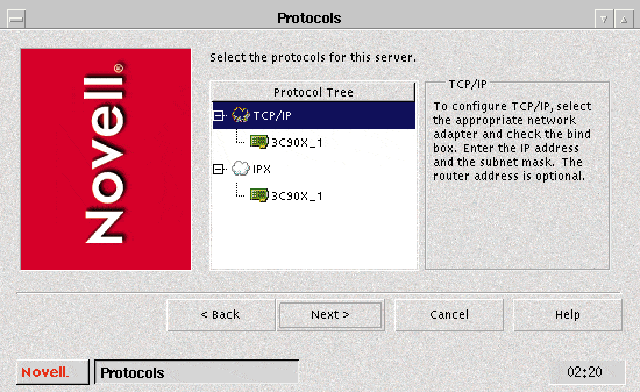In the landscape of network computing, few names are as synonymous with the pioneering days of local area networking (LAN) as Novell NetWare. Launched in the early 1980s, NetWare revolutionized the way computers connected, communicated, and shared resources across networks. As one of the first network operating systems (NOS) designed specifically for the corporate environment, it offered unprecedented file and print sharing capabilities, robust network security, and efficient network management tools.
This article embarks on a journey through the history of Novell NetWare, exploring its inception, the evolution of its various versions, and the factors leading to its deprecation. Through this exploration, we aim to shed light on NetWare’s significant contributions to the development of networking technologies and its lasting legacy in the field of network computing.
Table of Contents:
- Introduction
- The Inception of Novell NetWare
- Evolution of Novell NetWare Versions
- Technological Innovations and Contributions
- Competition and Challenges
- The Deprecation of Novell NetWare
- References
- Extra:

1. Introduction
1.1 Overview of Novell NetWare
Novell NetWare was a network operating system (NOS) that defined the early landscape of network computing. Debuting in the 1980s, it was among the first systems designed to facilitate file sharing, printer access, and other network services across multiple computers within a local area network (LAN). Unlike the standalone operating systems of the time, NetWare operated on a server-client model, dedicating a central computer as a server to manage resources and services for client computers on the network. This architecture allowed businesses to centralize data storage, streamline resource management, and enhance network security.
1.2 Significance in the history of network computing
NetWare’s introduction marked a pivotal moment in the evolution of IT infrastructure. It played a crucial role in transitioning from isolated computer systems to interconnected networks, promoting collaboration and efficiency in the workplace. NetWare’s robust file and print services, coupled with its emphasis on network security and reliability, set new standards for network management and operation. Its success not only demonstrated the potential of networked computing but also spurred the development of competing network operating systems, driving innovation and expansion in the field.
2. The Inception of Novell NetWare
Background and Origins of Novell as a Company
Novell, Inc. was founded in 1979 by George Canova, Darin Field, and Jack Davis, with an initial focus on hardware for disk controllers and computer networking. The company’s pivot to software came with the vision of Ray Noorda, who became the CEO in 1983. Noorda’s leadership steered Novell towards addressing the burgeoning need for networked computing solutions, leading to the development of NetWare.
Development and Launch of the First Version of NetWare
The development of NetWare was driven by the recognition of the limitations posed by existing standalone and proprietary systems, which hindered resource sharing and collaboration in growing business environments. The first version, NetWare 1.0, was launched in 1983. It was groundbreaking, offering a file-sharing system that allowed users to access files on a server as if they were located on their local drives, a novel concept at the time.
Key Features and Innovations Introduced
NetWare 1.0 introduced several key innovations that would become hallmarks of network operating systems:
- Dedicated Server Architecture: By dedicating hardware to serve as the network server, NetWare efficiently managed resources and services for client computers, optimizing network performance and reliability.
- File and Printer Sharing: NetWare’s ability to share files and printers among different users and workstations revolutionized office workflows, facilitating collaboration and resource optimization.
- Security and Access Control: NetWare implemented robust security measures, including user authentication and access controls, ensuring that sensitive information and resources could be protected from unauthorized access.
- Network Independence: Designed to operate over various types of network cabling and topologies, NetWare’s flexibility in deployment made it adaptable to diverse business environments.
These features laid the foundation for future versions of NetWare, each building upon the last to enhance functionality, improve performance, and adapt to the changing landscape of network technology and business needs.
3. Evolution of Novell NetWare Versions
3.1 NetWare 2.x: Expansion and new features
NetWare 2.x, introduced in the mid-1980s, marked a significant expansion of the NetWare platform. This version brought enhanced performance, increased maximum number of connectable users, and introduced support for larger disk volumes. It also featured the NetWare Loadable Module (NLM) technology, allowing third-party software vendors to extend the server’s capabilities with additional services and applications, such as database servers, backup solutions, and anti-virus programs.
3.2 NetWare 3.x: Introduction of the NetWare Core Protocol (NCP)
The release of NetWare 3.x in the late 1980s was a milestone in the product’s history, introducing the NetWare Core Protocol (NCP).

NCP provided a standardized method for client computers to request file, print, and other services from NetWare servers, significantly improving the efficiency and reliability of network operations. This version also made strides in network security, implementing enhanced authentication and encryption methods to protect data transmitted over the network.
3.3 NetWare 4.x: The introduction of Novell Directory Services (NDS)
NetWare 4.x, launched in the early 1990s, was revolutionary for its introduction of Novell Directory Services (NDS), a hierarchical directory service that allowed for centralized management of network resources, user accounts, and security policies. NDS was a game-changer in network management, offering a scalable, flexible solution that reduced the complexity of administering large, distributed networks. This version also emphasized interoperability, with better support for integrating NetWare into multi-vendor environments.
3.4 NetWare 5.x and Beyond: Support for Internet protocols and directory-enabled networking
With NetWare 5.x, released in the late 1990s, Novell embraced the Internet era, incorporating support for key Internet protocols like IP, DHCP, and DNS, moving beyond its traditional IPX/SPX protocols.

This version advanced directory-enabled networking, leveraging NDS (renamed to eDirectory) to manage not just network resources but also to facilitate web services and application settings, paving the way for what would become known as identity management solutions. NetWare 5.x and subsequent versions continued to evolve, integrating web technologies, enhancing security features, and improving management tools to address the needs of modern enterprises.
4. Technological Innovations and Contributions
4.1 Novell Directory Services (NDS) and its impact on network management
Novell Directory Services, later known as eDirectory, was arguably one of NetWare’s most significant contributions to network computing. As one of the first enterprise-level directory services, NDS provided a unified, hierarchical view of all network resources, including users, devices, applications, and services. This centralized approach drastically simplified network administration, particularly for large and complex environments, enabling policies, security settings, and resource allocations to be managed from a single point of control.
4.2 NetWare’s file and print services: Setting the standard for network resource sharing
NetWare set the gold standard for file and print services in a networked environment. Its efficient file handling and locking mechanisms ensured high performance and data integrity, even with multiple users accessing the same files. NetWare’s print services allowed for centralized management of printers, reducing hardware costs and streamlining print operations across the organization.
4.3 Security features and protocols introduced by NetWare
NetWare introduced several security features and protocols that became benchmarks for network security. Apart from user authentication and access control, NetWare implemented packet signing and encryption to secure data in transit. It was also among the first to use public key infrastructure (PKI) for network security, laying the groundwork for modern cryptographic and secure communication protocols in use today.
5. Competition and Challenges
5.1 Rise of competing network operating systems (Windows NT, UNIX-based systems)
The network operating system landscape began to shift significantly in the 1990s with the entry of powerful competitors like Windows NT from Microsoft and various UNIX-based systems. Windows NT, in particular, offered a compelling alternative to NetWare with its integrated network services, user-friendly interface, and aggressive marketing. UNIX-based systems, known for their stability and scalability, also provided robust networking capabilities, appealing to a segment of the enterprise market seeking alternatives to NetWare.
5.2 Challenges faced by Novell in adapting to the changing network computing landscape
Novell faced several challenges in adapting to these changes. Despite NetWare’s technical strengths, Novell struggled with marketing and positioning NetWare against the onslaught of Microsoft’s enterprise solutions, which benefited from seamless integration with the widely used Windows operating system. Additionally, the shift towards Internet-based protocols and services caught Novell at a disadvantage, as NetWare’s architecture was deeply rooted in its proprietary IPX/SPX protocol stack, making the transition to IP networking more complex.
6. The Deprecation of Novell NetWare
Factors Leading to the Decline of NetWare’s Popularity
The decline of NetWare’s popularity can be attributed to several factors:
- Integration with Windows: Microsoft’s Windows NT offered tight integration with its desktop operating systems, making it a more convenient choice for many organizations.
- Shift Towards Open Standards: The IT industry’s shift towards open standards and Internet-based networking favored TCP/IP over NetWare’s IPX/SPX, rendering NetWare’s core technologies less relevant.
- Market Perception: Novell’s perceived delay in adapting to new technologies and market trends contributed to a loss of confidence among its user base and potential customers.
Transition of Novell’s Focus Towards Other Products and Services
In response to these challenges, Novell began to diversify its product portfolio, shifting its focus towards directory services, identity management, and cross-platform solutions. The transformation was marked by the development of products like eDirectory and GroupWise, and strategic acquisitions aimed at strengthening Novell’s position in these areas.
Legacy and Migration Paths for NetWare Users
Despite the decline in NetWare’s popularity, Novell provided migration paths for NetWare users, facilitating their transition to more modern platforms and services. Novell’s Open Enterprise Server (OES), which integrates Linux with NetWare services, offered a direct migration path, allowing users to maintain their investment in Novell’s technologies while leveraging the advantages of Linux.
7. References
Books
- “Novell’s NetWare 6 Administrator’s Handbook” by Kelley J. P. Lindberg
- “Networking Essentials” by Jeffrey S. Beasley and Piyasat Nilkaew – Offers foundational knowledge on networking principles, including a historical overview of NetWare.
RFCs
- RFC 1791 – “TCP And UDP Over IPX Networks With Fixed Path MTU” – Provides insights into the integration of IPX/SPX with TCP/IP, reflecting Novell’s efforts to adapt NetWare to the evolving network landscape.
Microsoft Windows (NT/2000) services for NetWare
Microsoft Windows NT and Windows 2000 offer many services for interoperating with and migrating from NetWare servers and networks, including the following:
- NWLink IPX/SPX-Compatible Transport
- Gateway Service for NetWare (GSNW)
- Client Services for NetWare (CSNW)
- File and Print Services for NetWare (FPNW)
A Novell Netware v3.12 working (video)
See also: